Diving with Surgeonfishes & Tangs
Lanta Marine Life | Acanthuridae
Surgeonfishes, tangs, and unicornfish are 86 tropical species which make up the family Acanthuridae, and several species are regularly seen during Koh Lanta dive trips.
All members have a deep compressed body with the eye high on the head. Members of the genus Naso, commonly known as unicornfish, have a horn-like projection in front of the eye.
Living mostly on coral reefs, members of this family are mostly brightly coloured and are known for the one or more dangerously sharp, scalpel-like spines on each side of the tail base (the caudal peduncle). Family members with a single spine can fold this into a horizontal groove on the tail base, however in species with more than one spine, the spines are fixed in position. They can defend themselves and slash other fish with a flick of their tail.
The mouths are small and have a single row of close-set teeth adapted to grazing on algae. Surgeonfishes sometimes feed as solitary individuals, but they can also often travel and feed in schools. When feeding in schools, they can easily overwhelm territorial fish such as aggressive damselfish which may be guarding small patches of algae on a coral reef.
Surgeonfish fertilization is external and they may gather in large numbers before spawning. Most surgeonfish spawn in groups although some form spawning pairs or groups of pairs. They are broadcast spawners and have pelagic eggs and larvae.
17 species found on this page:
- Eyestripe Surgeonfish (Acanthurus dussumieri)
- Lined Surgeonfish (Acanthurus lineatus)
- Convict Surgeonfish (Acanthurus triostegus)
- Powderblue Surgeonfish (Acanthurus leucosternon)
- Brown Surgeonfish (Acanthurus nigrofuscus)
- White-Freckled Surgeonfish (Acanthurus maculiceps)
- Blackstreak Surgeonfish (Acanthurus nigricaudus)
- Indian Mimic Surgeonfish (Acanthurus tristis)
- Yellowfin Surgeonfish (Acanthurus xanthopterus)
- Whitetail Surgeonfish (Acanthurus thompsoni)
- Orangespine Unicornfish (Naso lituratus)
- Bluespine Unicornfish (Naso unicornis)
- Bignose Unicornfish (Naso vlamingii)
- Lined Bristletooth Surgeonfish (Ctenochaetus striatus)
- Indian Gold Ring Bristletooth Tang (Ctenochaetus truncatus)
- Twospot Bristletooth Surgeonfish (Ctenochaetus binotatus)
- Brushtail Tang (Zebrasoma scopas)
Eyestripe Surgeonfish
(Acanthurus dussumieri)
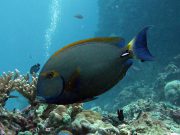
Acanthurus dussumieri @ Koh Haa
The Eyestripe Surgeonfish surgeonfish has a brownish to bluish body with many horizontal wavy lines. There is a dark yellowish stripe or blotch through the eye and the lips are lighter than the head colour. The dorsal and anal fins are mostly yellow, with a blue patch at the rear. The tail fin base is yellowish-whitish, and the tail is mostly blue with many dark spots.
The Eyestripe Surgeonfish grows to 50 cm, but more often observed around 30 cm - 35 cm. This species is usually seen alone, but sometimes forms small groups.
Lined Surgeonfish
(Acanthurus lineatus)
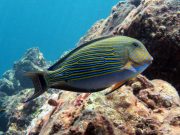
Acanthurus lineatus @ Koh Haa
The Lined Surgeonfish, or Striped Surgeonfish has a yellow body and golden head, with a pale grey underbody or belly. There are many horizontal black-edged blue stripes along the body, with similar diagonal stripes on the head and radiating from the eye. The pectoral fin shares the same black-edged blue stripe markings. The pelvic fin is yellow with a dark margin, and the dorsal and tail fins are dark. There are one or more black-edged vertical blue bands on the tail base.
The Lined Surgeonfish grows to 38 cm, but more usually observed in the 20 cm - 25 cm range. Often seen in small to medium sized groups, usually in shallower parts of the reef around rocky valleys and algae rich surfaces. The tailfin spine is venomous and causes painful wounds.
Convict Surgeonfish
(Acanthurus triostegus)

Acanthurus triostegus @ Koh Rok
The Convict Surgeonfish has a pale yellowish upper body and whitish lower body with 5 - 6 vertical black bars. The forward-most bar is always through the eye, and there is a small black band from the forehead to the snout.
The Convict Surgeonfish grows to 25 cm and can occasionally be seen feeding in small groups among the shallow reef areas at Koh Rok.
This species is very rarely seen at any of our other dive sites.
Powderblue Surgeonfish
(Acanthurus leucosternon)

Acanthurus leucosternon @ Koh Haa
The Powderblue Surgeonfish has a black head with white patch below in the 'neck' area, and a power-blue body. The dorsal fin and tail fin base are yellow, and the pelvic and snal fins are white.
The Powderblue Surgeonfish grows to 38 cm, but more usually observed in the 15 cm - 20 cm range. This species is a common sight at the dive sites around Koh Lanta and can be seen alone, or in small groups.
Brown Surgeonfish
(Acanthurus nigrofuscus)

Acanthurus nigrofuscus @ Koh Haa
The Brown Surgeonfish has a lavender to tan to brown body. The head may be dark, or a pale greyish-bluish colour.
There are many fine spots on the head and chest area, which may be orangish to bluish-white in colour.
The body may have many fine bluish grey horizontal lines. All colour variations have a black spot at the rear base of the last dorsal and anal fin rays.
The Brown Surgeonfish grows to 21 cm and is one of the smallest of the surgeonfishes. This species feeds on algae grazed from rocky surfaces, sometimes in small schools.
White-Freckled Surgeonfish
(Acanthurus maculiceps)

Acanthurus maculiceps @ Koh Haa
The White-Freckled Surgeonfish has a black head with numerous white spots and a pale to dark grey body.
There is a small black streak behind the top of the gill cover, and the pectoral fin may have a yellow tip.
The tail fin is dark, often with a vertical white stripe on the tail fin base. The tail spine has a black margin.
The White-Freckled Surgeonfish grows to 40 cm, but more usually observed 20 cm - 25 cm in length.
This species is usually observed solitary, but may form small groups from time to time.
Blackstreak Surgeonfish
(Acanthurus nigricaudus)

Acanthurus nigricaudus @ Koh Haa
The Blackstreak Surgeonfish has a pale grey to brown to near-black coloured body and a long black streak or bar behind the eye to above the pectoral fin.
There is often (but not always) a thin dark streak on the rear body to the tail fin base. The tail fin base has a vertical white bar, and the pectoral fin often has a yellow margin.
The Blackstreak Surgeonfish grows to 40 cm, but usually observed around 25 cm - 30 cm.
This species can be found over sandy and rubble areas at the edge of coral rich areas.
Indian Mimic Surgeonfish
(Acanthurus tristis)
The Indian Mimic Surgeonfish has a tan to dark brown body, with a grey face. There is a curving black band from under the mouth to the top of the gill cover and a black patch over the pectoral fin base.
There is a small white or pale grey bar from the chin to the upper lip, just behind the mouth opening. The tail is dark and has a thin white or yellowish margin.
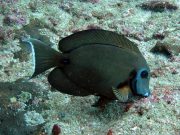
Acanthurus tristis @ Koh Haa
Juveniles have very similar colouring to the Blacktail Angelfish (Centropyge eibli).

Indian Mimic Surgeonfish @ Koh Haa
Indian Mimic Surgeonfish grow to 25 cm and are often seen around Koh Haa Lagoon and other sandy areas close to rich coral reefs.
Yellowfin Surgeonfish
(Acanthurus xanthopterus)
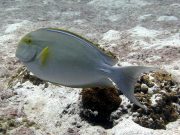
Acanthurus xanthopterus @ Koh Haa
The Yellowfin Surgeonfish has a grey to greyish-brown to bluish body. The pectoral fins are yellow to yellowish and there is a yellow band passing through the eye.
There may be a white ring around the tail, however this is not always present. The dorsal and anal fins may have a hint of yellow margin to them, and the tail fin lobes are elongate.
The Yellowfin Surgeonfish grows to 56 cm and is the largest of all surgeonfish.
This species can be seen solitary, or in small groups feeding in sandy areas near the reef edge. Often seen in deeper areas outside The Lagoon at Koh Haa, or off the south east / east side of Koh Haa Yai.
Whitetail Surgeonfish
(Acanthurus thompsoni)

Acanthurus thompsoni @ Koh Haa
The Whitetail Surgeonfish has a uniformly dark body colour, very dark blue to dark brown, with a snow-white tail fin. The pectoral fins may have a yellowish tinge.
The Whitetail Surgeonfish grows up to 27 cm and may change colour when disturbed.
This is a rarely observed species at the Koh Lanta dive sites.
Orangespine Unicornfish
(Naso lituratus)
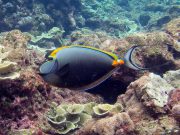
Naso lituratus @ Koh Haa
The Orangespine Unicornfish has a brownish-grey to dark-grey body, is yellow above the eyes and has a yellow-edged black area from the mouth to the eye. The lips are usually orange. There is a pair of bright orange tail fin spines on each side.
There is usually no horn-like projection on this species, however some rare individuals do have a very small black horn-like projection between the eyes.
The Orangespine Unicornfish grows to 46 cm, but more usually observed around 25 cm - 30 cm.
Bluespine Unicornfish
(Naso unicornis)

Naso unicornis @ Koh Haa
The Bluespine Unicornfish has a greyish-blue to olive-blue body, slightly darker on the upper body and lighter on the lower body. The tail is dark, with a light margin, and the tail fin lobes are extended. The double tail fin spines are bright blue. There is a short horn between the eyes which does not extend past the snout.
The Bluespine Unicornfish grows to 70 cm, but usually observed in the 25 cm - 35 cm range. This species feed on algae and is usually seen in shallow water over coral rich areas and over sand close to coral rich areas. The diet includes coarse leafy brown algae seaweeds such as Sargassum.
Bignose Unicornfish
(Naso vlamingii)

Naso vlamingii @ Hin Daeng
The Bignose Unicornfish has a blue to brown body with a dark horizontal stripe extending from the eye to a large bump on the head.
The side of the body has many thin horizontal lines which become rows of spots on the upper body.
The forward eye stripe and body stripes can be changed from brown to blue at will, with brown being the camouflage colour.
The Bignose Unicornfish has tall dorsal and anal fins and the tail fin has long trailing filaments on the top and bottom. This species has a double spine at the tail fin base.
The Bignose Unicornfish grows to 60 cm and the diet includes zooplankton.
Lined Bristletooth Surgeonfish
(Ctenochaetus striatus)

Ctenochaetus striatus @ Koh Haa
The Lined Bristletooth Surgeonfish has a generally dark olive to yellowish brown body, with many faint orange spots around the eye and forehead. The body has many faint, fine wavy horizontal blue lines. There is often a white or pale blue spot on the head, directly in front of the eyes, and possibly also under the chin. Juveniles and small adults may also have a small black spot at the rear base of the dorsal fin.
The Lined Bristletooth Surgeonfish grows to 26 cm, but more usually observed 15 cm - 18 cm. The diet includes several species of toxic algae, and these toxins accumulate in the body, making this a poisonous fish to eat.
Indian Gold Ring Bristletooth Tang
(Ctenochaetus truncatus)

Ctenochaetus truncatus @ Koh Haa
The Indian Gold Ring Bristletooth Tang has an olive-brownish to dark grey body completely covered in hundreds of tiny light blue to yellowish spots.
The spots merge on some parts of the body to form short wavy lines. The top of the eye is yellow.
The pectoral fin is translucent yellowish. The rear of the dorsal and anal fins are angular.
The Indian Gold Ring Bristletooth Tang grows to more than 25 cm. This is a poorly documented species.
Twospot Bristletooth Surgeonfish
(Ctenochaetus binotatus)
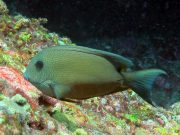
Ctenochaetus binotatus @ Koh Haa
The Twospot Bristletooth Surgeonfish has an olive-brown to orangish-brown body with many whitish to orangish spots on the head, becoming almost wavy lines along the length of the body and on to the tail base.
There is a black spot at the rear of the dorsal fin base and anal fin base. The tail can be olive-greenish to yellowish.
The Twospot Bristletooth Surgeonfish grows to 22 cm, but usually observed in the 15 cm to 18 cm range.
As with several other surgeonfishes, the diet includes some species of algae which are toxic. These toxins can accumulate within the body over time and eating this fish is not recommended.
Brushtail Tang
(Zebrasoma scopas)
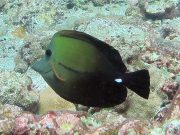
Zebrasoma scopas @ Koh Haa
The Brushtail Tang, sometimes known as the Two-Tone Tang, has a yellowish brown head and forebody, gradating to nearly black on the tail. The eye is black and the pectoral fin is lightly coloured.
There is a dark patch of brush-like bristles in front of the bright white tail spine. There are many small pale blue to blue-green spots and wavy lines on the head and body.
The Brushtail Tang grows to 20 cm, but usually observed around 12 cm - 15 cm. This species can be solitary or form pairs for breeding.
Diving with Surgeonfishes & Tangs around Koh Lanta
Scuba Diving & Snorkel Trips
If you'd love a chance to spot Surgeonfishes & Tangs on one of our daily high season diving trips from Koh Lanta then send us an email to info@diveandrelax.com.
Join our high season speedboat dive trips to some of Thailand's best dive sites and enjoy small groups, short journey times, with a focus on great personal service, safety and fun.
Not yet a certified diver? Learn to Scuba Dive on Koh Lanta with the 3 day SSI Open Water Diver course.
Book online to save 10% on dive trips and scuba courses on Koh Lanta.
Find Out More
Indo-Pacific Marine Life Guides
- Allen, G., Steene, R., Humann, P., DeLoach, N. (2003) Reef Fish Identification, Tropical Pacific. Jacksonville, FL., USA: New World Publications, Inc., ISBN 1-878348-36-1.
- Humann, P., DeLoach, N., (2010) Reef Creature Identification, Tropical Pacific. Jacksonville, FL., USA: New World Publications Inc., ISBN 978-1-878348-44-9
- Debelius, H. (2013) Indian Ocean Reef Guide. Frankfurt, Germany: IKAN - Unterwasserarchiv, ISBN 978-3-939767-52-7.
- Debelius, H. (2004) Nudibranchs and Sea Snails, Indo-Pacific Field Guide. Frankfurt, Germany: IKAN - Unterwasserarchiv, ISBN 3-925919-51-1
- Erhardt, H., Knop, D. (2015) Corals Indo-Pacific Field Guide. Frankfurt, Germany: IKAN - Unterwasserarchiv, ISBN 3-925919-69-4.
- Veron J.E.N., Stafford-Smith M.G., Turak E. and DeVantier L.M. (2016). Corals of the World
